Roman fort at St Julia de Ramis (Girona)
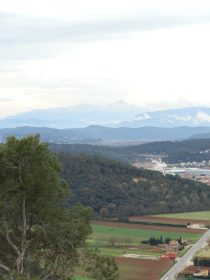 Geographically and historically Girona is a key gateway to Spain and the Iberian Peninsular. Though Figueres and the pass at Le Boulou (El Volo)/Le Perthus over the Pyrenees mark the border (since about 1659) and start point into the plains of Emporda, the plains of Emporda themselves are blocked to the west by the foothills of the Pyrenees and to the south by the Gavarres. Consequently any invading army wanting to go south for all practical purposes has to pass through Girona to be able to go south, or any army coming from the south has to pass through Girona to go north.
Geographically and historically Girona is a key gateway to Spain and the Iberian Peninsular. Though Figueres and the pass at Le Boulou (El Volo)/Le Perthus over the Pyrenees mark the border (since about 1659) and start point into the plains of Emporda, the plains of Emporda themselves are blocked to the west by the foothills of the Pyrenees and to the south by the Gavarres. Consequently any invading army wanting to go south for all practical purposes has to pass through Girona to be able to go south, or any army coming from the south has to pass through Girona to go north.
As a result Girona and the hills around Girona have been of major strategic importance for the numerous invasions and incursions across the Spanish French border. According to reports, Girona itself has been beseiged twenty five times in its history. As a result Girona is surrounded by castles and fortifications in various states of disrepair. The city itself was heavily walled during the 17th century, though many of these fortifications have been removed.
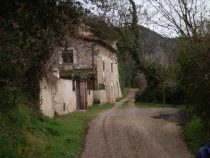 For the Romans, Girona (Gerunda) was a key strategic outpost on the Via Augusta (now AP7 and N II) leading from the south of Spain all the way to Rome, whilst the easterly route to the coast would have take the Roman's towards the Empordan Plain to the East and out to the Roman city of Empuries following the river Ter. At the point the Ter curves round the Gavarres it passes through the narrow valley between Sant Julia de Ramis and Campdora. The hills around this point have several castles and fortifications that can be seen from the autoroute, but it also remains a major junction point, consequently walking in what is a historic area, has to be done with a background of road and rail noise.
For the Romans, Girona (Gerunda) was a key strategic outpost on the Via Augusta (now AP7 and N II) leading from the south of Spain all the way to Rome, whilst the easterly route to the coast would have take the Roman's towards the Empordan Plain to the East and out to the Roman city of Empuries following the river Ter. At the point the Ter curves round the Gavarres it passes through the narrow valley between Sant Julia de Ramis and Campdora. The hills around this point have several castles and fortifications that can be seen from the autoroute, but it also remains a major junction point, consequently walking in what is a historic area, has to be done with a background of road and rail noise.
The walk starts in Sant Julia de Ramis by the Ajuntament. To reach it you have to take a right off the N II heading north. Unfortunately it's easy to miss if you're not sure where you're going, so we had to continue on the N II to the roundabout and turnaround before finally being able to make the junction. There is a map of the walk outside the Ajuntament - we kept it simple and just followed the marked route. This takes you along out along the flat of the river following the Ter as it flows through the valley. Around are the road and railways but the walk itself is pleasant enough if unspectacular. We saw our first snowdrops in Spain. The walk continues at the base of the hill past a set of caves and out into the plains behind Celra. The Ter valley at this point all the way to Flaca is planted with birch trees. We were trying to work out why such flat and apparently arable land wouldn't be used for crops and wondered if this is an area that would have been flooded by the Ter with the spring snow melts (before the Ter dam was built higher up) which would have precluded other types of crops?
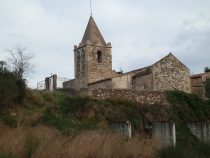 On the opposite side of the valley is a large disused factory built of brick. With the noise of the traffic at this point it feels more like a walk with industrial heritage. Celra itself has a couple of historical factories in a modernista style, but that is for another day. Eventually the path curves turns to the left (careful with the signpost, the sign points right, but the arrow on the sign points left) and starts to climb into the woods passing under the N II. And then it becomes a pretty wooded walk up to the top following the sign posts.
On the opposite side of the valley is a large disused factory built of brick. With the noise of the traffic at this point it feels more like a walk with industrial heritage. Celra itself has a couple of historical factories in a modernista style, but that is for another day. Eventually the path curves turns to the left (careful with the signpost, the sign points right, but the arrow on the sign points left) and starts to climb into the woods passing under the N II. And then it becomes a pretty wooded walk up to the top following the sign posts.
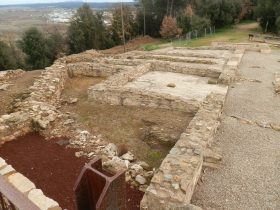 At the top is a small church - you can climb the tower. There are views out along the Ter towards the sea and you can see Roses, the small hill at Montgo (near L'Escala) and the castle on the Montgri mountain in the distance. Below, along the N II to the north you'll see the next castle (Madremanya - it looks prettier from further away than from up close). Then follow the path from the church to the Roman remains of the fort Castellum Fractum. This has been excavated and there are signs and information. From the fort you can look south down the Onyar valley towards the mountain of Montseny and on the other side of the valley is Campdora and further castle ruins.
At the top is a small church - you can climb the tower. There are views out along the Ter towards the sea and you can see Roses, the small hill at Montgo (near L'Escala) and the castle on the Montgri mountain in the distance. Below, along the N II to the north you'll see the next castle (Madremanya - it looks prettier from further away than from up close). Then follow the path from the church to the Roman remains of the fort Castellum Fractum. This has been excavated and there are signs and information. From the fort you can look south down the Onyar valley towards the mountain of Montseny and on the other side of the valley is Campdora and further castle ruins.
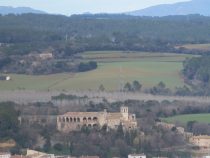 The Roman fort is not the fort that you can see from the autoroute. To reach this area you have to continue the loop around the top and you eventually reach the wall of Castell Forti. This was built in the 19th century and when we were there was totally closed off for works. The signpost said it was a private property, so I do not know if it will be open to the public in future.
The Roman fort is not the fort that you can see from the autoroute. To reach this area you have to continue the loop around the top and you eventually reach the wall of Castell Forti. This was built in the 19th century and when we were there was totally closed off for works. The signpost said it was a private property, so I do not know if it will be open to the public in future.
The road down then brings you back to Sant Julia.
Girona walks: Celra, Juia and the Castle of Palagret - Girona valley of Sant Daniel - Girona and Castell de St Miquel - Cervia de Ter - Bascara - horses, fords and lost - Palol de Revardit to La Mota - Bescano, River Ter and free-style kayaking - Celra, Juia and the Castle of Palagret
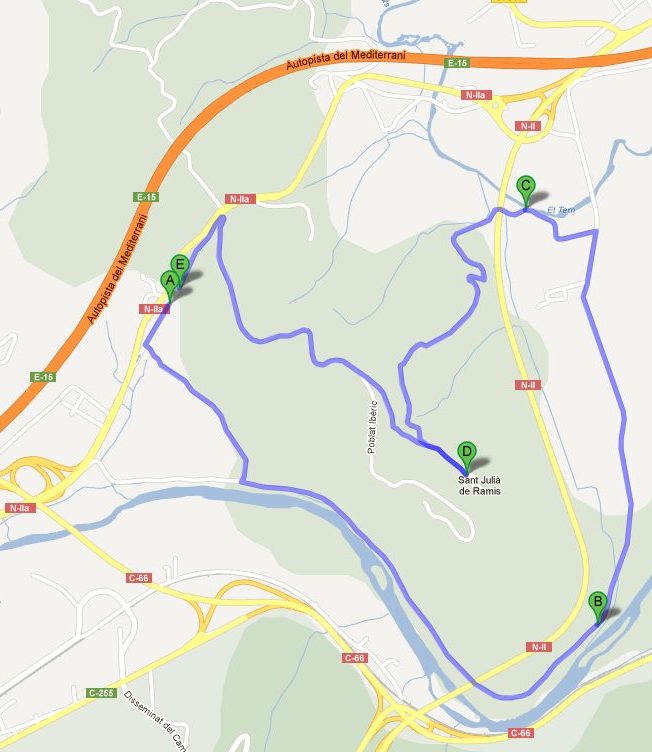


 Walks and other things
Walks and other things